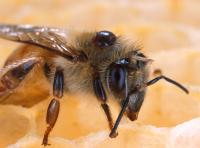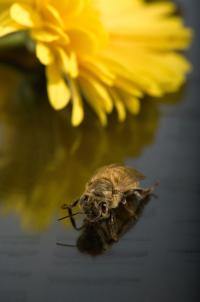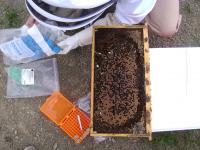
Honey bee worker carrying a parasitic Varroa mite. A comparison of healthy and unhealthy bee colonies points to a virus contributing to Colony Collapse Disorder (CCD), according to a report being published by the journal Science, at the Science Express web site, on 06 September. Science is published by AAAS, the nonprofit science society.
“Our extensive study suggests that the Israeli Acute Paralysis Virus (IAPV) may be a potential cause of Colony Collapse Disorder,” said W. Ian Lipkin, director of the Center for Infection and Immunology at the Mailman School of Public Health, Columbia University. “Our next step is to ascertain whether this virus, alone or in concert with other factors such as microbes, toxins and stressors, can induce CCD in healthy bees,” he added. 
Honey bee reflecting on DNA gel data.
CCD is a puzzling phenomenon occurring in the United States – and possibly other countries where it is not yet confirmed – in which all adult bees disappear from the hive, leaving the honey and pollen behind. Few, if any, dead bees are found around the hive.
Between 50 and 90 percent of the commercial honey bee (Apis mellifera) colonies in the United States have been afflicted by CCD, and the disorder is making it difficult for U.S. commercial beekeepers to pollinate crops. About a quarter of beekeeping operations were affected by CCD during the 2006-2007 winter alone.
Researchers including Lipkin and Diana Cox-Foster, entomology professor at Pennsylvania State University, and colleagues have taken a new approach to investigating infectious disease outbreaks. To find the cause of CCD they used a rapid genome sequencing technique called pyrosequencing to catalogue the entire variety of microorganisms that honey bees harbor. After comparing their sequences with known sequences held in public databases, they identified symbiotic and pathogenic bacteria, fungi and viruses found in both healthy and CCD-afflicted colonies. 
Field collection materials for forensic samples from honey bee colonies.
They tested samples collected over three years across the United States from normal and CCD-affected hives. They also tested royal jelly imported from China, which is fed to bee larvae to start up a new colony, as well as apparently healthy bees imported from Australia, in an attempt to locate a source for an infectious agent. After detailed statistical comparison of all the samples, the molecular signs of Israeli Acute Paralysis Virus appeared to be associated with CCD.
“This research gives us a very good lead to follow, but we do not believe IAPV is acting alone,” said coauthor Jeffery S. Pettis, research leader of the Bee Research Laboratory, United States Department of Agriculture. “Other stressors to the colony are likely involved,” he said. Those stressors could be poor nutrition, pesticide exposure and parasitic mites.
The next research steps include inducing CCD in healthy bees, determining the global distribution of IAPV and CCD and studying bees that appear to be resistant to CCD.
Source : American Association for the Advancement of Science
 Print Article
Print Article Mail to a Friend
Mail to a Friend
